pytest发现规则
- 如果没指定参数,并且配置了 testpaths (详见1.testpaths),会从 testpaths 查找,否则从当前目录查找。也可以通过命令行指定目录,文件名,节点 id 的组合。
- 递归目录,直到遇到
norecursedirs(详见3.norecursedirs)为止 - 在所有目录中搜索
test_*.py或者*_test.py文件,并通过测试包名(详见4. 测试包名)导入他们。 - 从文件中收集测试项,包括:
-
test开头的函数或类外方法 -
test开头的函数或方法,在Test开头的类中(这个类不能有 __init__方法)
-
1.testpaths
从 rootdir 下的 testpaths 开始找 test(如果命令行没设置其他的目录,文件,或测试ids) ,它可以加速测试收集,过滤掉不想要的测试内容。
创建如下目录结构,在 tox.ini 文件中加入 testpaths :

tox.ini 配置文件如下:
[pytest]
testpaths = a/a1
可以看到, pytest 设置 tox.ini 文件为 inifile ,同时设置了 testpaths ,并且只从 a/a1 目录下收集测试项:
2.rootdir
rootdir 的作用如下:
- 构建
nodeids时,每一个 test 都有唯一的标识 nodeid ,标识的根目录就是rootdir,包括绝对路径,类名, 函数名和参数化。 - 存放插件的测试信息,比如 cache 插件在
rootdir下创建了.pytest_cache目录存储交叉测试运行状态。
比如当 rootdir 为 pytest_example 时,其下就存在 cache 插件存放目录 .pytest_cache :
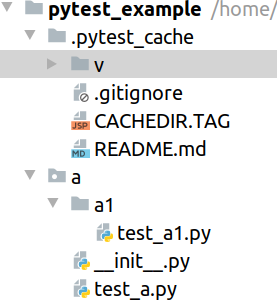
可以用命令行参数或者 ini_file 指定 `rootdir :
-
--rootdir=path可以设置 rootdir 目录 - 用
pytest.ini中的 addopts 参数可以修改 pytest 默认参数
pytest.ini 内容如下,它指定 pytest 命令的默认参数为 --rootdir=path ,当只执行 pytest 命令时,会自动加上 --rootdir=path :
# content of pytest.ini or tox.ini
[pytest]
addopts = --rootdir=path
如果不显示指定 rootdir 的位置, pytest 会按照下述规则自动寻找 rootdir :
- 寻找多个参数的共同祖先目录,如果没有,将当前工作目录设置为共同祖先目录。
- 从共同祖先目录及上级目录中找三个文件
pytest.ini,tox.ini和setup.cfg,若找到其中任何一个文件,则将其变为ini-file,而它所在的目录就是rootdir。 - 如果没有
ini-file,从共同祖先目录及上级目录中找setup.py,如果有,则将其所在目录设为rootdir。 - 如果没有
setup.py,从每个参数及其上级目录中找pytest.ini,tox.ini和setup.cfg, 如果找到,它将成为 ini-file ,并且其目录将成为rootdir。 - 如果没有 ini-file ,把共同祖先目录作为 rootdir,这么做的原因是,即使不是包,且没有配置文件,也能使用 pytest 。
比如以下目录,请注意其中的 pytest.ini 文件位置:

运行如下 pytest 命令, pytest 首先找到两个参数的公共祖先目录 a ,然后从 a 目录中找到了 pytest.ini 文件,于是这个文件就是 inifile ,而 rootdir 就是目录 a :
将 pytest.ini 的位置放入 a1目录下:
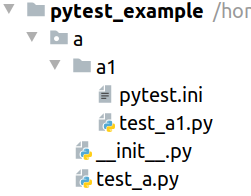
pytest 首先找到了公共目录 a ,但是在目录 a 及其上级目录没有发现任何配置文件(pytest.ini , tox.ini 和 setup.cfg,setup.py),于是从每个参数及其上级目录中找,发现目录 a1 下存在 pytest.ini ,它将成为 ini-file ,并且其目录将成为rootdir。
没有 pytest.ini 文件时, rootdir 是 pytest_example 而不是 a , 比如下图
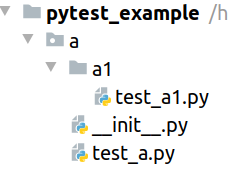
如果没有参数, pytest 会把当前目录设为 rootdir 。比如参考以下目录结构和运行结果:
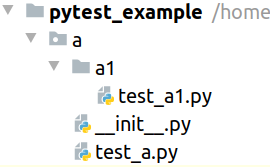
即使设置了 pytest.ini ,如果 pytest 没有参数的话,会把当前目录 a 设置为 rootdir :
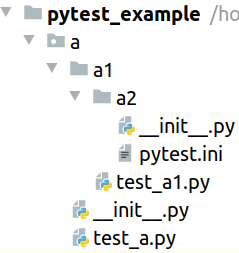
注意:只要存在 pytest.ini 文件,就能被 pytest 匹配上,但是 tox.ini 和 setup.cfg 必须包含 [pytest] 或者 [tool:pytest] 部分才能被匹配,如果有多个 ini-file ,最终只会挑选出一个(优先选择pytest.ini)。 pytest 存在一个 bug ,用户可以自定义插件,插件可以传参,如果传入的是路径,比如 pytest --log-output ../../test.log args,上述插件不写 args 的话, pytest 会使用 test.log 文件夹确定rootdir(参见issue 1435),比如 pytest --log-output ../../test.log 。即使用点 . 来引用当前工作目录,也会发生上述问题。
3.配置 norecursedirs
https://docs.pytest.org/en/latest/reference.html#confval-norecursedirs
设置目录的基本名字表达式(fnmatch-match风格),用于是否进行递归。
* 匹配所有内容
? 匹配所有单字符
[seq] 匹配 seq 中的任一个字符
[!seq] 匹配不在 seq 中的字符
默认表达式有 :
'.*', 'build', 'dist', 'CVS', '_darcs', '{arch}', '*.egg', 'venv' ,可以设置norecursedirs替代默认表达式,比如不递归指定目录:
[pytest]
norecursedirs = .svn _build tmp*
pytest 会通过 activation 脚本识别并忽略 python 虚拟环境, pytest 不会收集虚拟环境中的 test ,但可以使用 ‑‑collect‑in‑virtualenv 选项开启收集。注意,norecursedirs 级别高于 ‑‑collect‑in‑virtualenv ,比如你开启了 ‑‑collect‑in‑virtualenv 选项,就必须重写 norecursedirs 才能让其生效(因为默认值有 venv 会过滤掉虚拟环境)。
比如下面的目录结构,在 pytest_example 目录下存在配置文件 tox.ini :

tox.ini 的内容如下:
[pytest]
norecursedirs = a1
4. 测试包名
如果 pytest 发现一个测试文件 a/b/test_module.py ,会发生以下情况:
- 设置
basedir:发现第一个不包含__init__.py的上级目录,如果a和b都包含__init__.py文件,a的父目录将成为basedir。 - 使用
sys.path.insert(0, basedir)将 basedir 置于环境变量的首位。 -
import a.b.test_module把路径分割符\转换成了 “.” ,让目录名和文件名直接映射到导入名。
在较大的项目中,可能会相互导入多个测试模块,规范的导入名称可规避意外情况,例如一个测试模块被导入两次。
测试
1. 无参数
现在不对 pytest 设置额外参数,不设置 testpaths ,也不设置 norecursedirs 。假设以下目录结构,在目录 pytest_example 下有一个包 a ,它下面 存在一个 test_a.py 和目录 a1 ,目录 a1 下面存在 test_a2.py:
pytest_example/
|- a/
|- __init__.py
|- test_a.py
|- a1/
|- tests/
|- test_a1.py
test_a.py 和 test_a1.py 的代码和执行结果分别如下:
# 以下是 test_a.py 代码
def test_a():
print('test_a')
# 以下是 test_a2.py 代码
class Test_A1:
def test_a1(self):
print("test_a1")
使用命令行 cd 到 pytest_example 目录下,执行 pytest 命令,其结果如下:
可以看出, pytest 从 pytest_example 目录开始递归收集测试,收集到了两个测试内容: test_a.py 和 test_a1.py,它不会区分包和目录,也不会捕获标准输出, 输出结果打印 rootdir 的内容 ,后面会讲它的作用。








